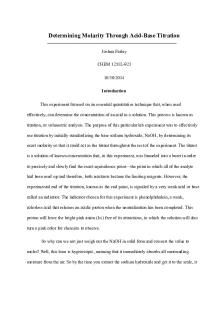CHE443 Amino Acid Titration Lab Report PDF

| Title | CHE443 Amino Acid Titration Lab Report |
|---|---|
| Course | Biochemistry I with Lab |
| Institution | California Baptist University |
| Pages | 3 |
| File Size | 239.9 KB |
| File Type | |
| Total Downloads | 16 |
| Total Views | 194 |
Summary
This is the first lab report for biochemistry I with Dr. Jones Tsai. This was in the fall of 2020, which we had in person labs but online lectures....
Description
Amino Acid Titration Author: Paige Hutton (CHE443-B) Lab Members: Montana Griff, Sydney Munck
Introduction: Titration is the method of slowly entering a basic solution into an acidic environment for the purpose of establishing a neutralization— and therefore, finding an equilibrium point located on a titration curve. Since the human body needs to be in homeostasis, it is essential to recognize the acidity of amino acids in order to further understand how these building blocks of the body function and interact with other bodily components. Amino acids fall into the categories of non-polar amino acids, acidic amino acids, and basic amino acids. Each of these categories have their own characteristics, specifically their charges based upon their attached carbon chain groups. Both non-polar and polar amino acids have a net charge of zero. A carboxyl group has one negative charge due to the electronegativity of the oxygen, while an amino group will have one positive charge. When analyzing pKₐ values for amino acids, basic amino acids will follow the RH⁺ values for their carbon chain attachments, while acidic and neutral amino acids will follow the RH values for their carbon chain attachments. A titration curve of an amino acid will allow identification of different parts of the slope— such as the pKₐ’s and the points of equilibrium. The pKₐ of an acid is especially important when it is equal to the pH, also known as a half equivalence point, due to the fact that at this point, there is not one dominant charged form of the amino acid, but rather a mix of two charged forms. At this point, the solution will also be resistant to changes in pH, meaning that it is an adequate buffer zone. The first point of equilibrium is reached when a sufficient volume of base has been added to neutralize the acid. The equivalence point of a non-polar amino acid comes between the pK₁ and pK₂ points on the curve, which is also considered the isoelectric point (pI). For basic and acidic amino acids, the equilibrium points come between the pK ₂ and pK ₃ points on the titration curve. The pI is the average between two certain pKₐ points, and it is also the point in which the amino acid is a zwitterion—meaning that its charge is neutral. How the pH of the environment affects the charge of an amino acid is significant because it determines its function and bonding capabilities.
Materials and Methods: The PASCO pH monitoring system was set up on the iPad and the probe was calibrated with both standard solutions. A pH reading was taken of the amino acid alanine, which was our known amino acid used for comparison of our unknown amino acid. The pH values of alanine were recorded in intervals of adding 300 µL and after allowing the stir bar to sufficiently mix the two solutions together. After successfully recording the peaks of alanine during titration. Subsequently, a titration was performed with unknown amino acid (B) and was recorded at 300 µL of NaOH intervals as well. Following the experimental procedure, the data was translated into titration curves for both specimens. Based upon the titration curves, the identity of the unknown amino acid (B) is determined along with its pK values.
Results: Alanine Data Amount of NaOH Added (µL) 300 µL 600 µL 900 µL 1200 µL 1500 µL 1800 µL 2100 µL 2400 µL 2700 µL 3000 µL 3300 µL 3600 µL 3900 µL 4200 µL 4500 µL 4800 µL 5100 µL 5400 µL 5700 µL 6000 µL 6300 µL 6600 µL 6900 µL 7200 µL 7500 µL
Unknown B Data pH 1.37 1.50 1.65 1.81 1.94 2.09 2.25 2.40 2.56 2.76 3.03 3.51 8.29 9.09 9.42 9.65 9.82 9.98 10.15 10.31 10.47 10.69 10.95 11.35 11.90
Jump in pH
Alanine Titration Curve
Amount of NaOH Added (µL) 300 µL 600 µL 900 µL 1200 µL 1500 µL 1800 µL 2100 µL 2400 µL 2700 µL 3000 µL 3300 µL 3600 µL 3900 µL 4200 µL 4500 µL 4800 µL 5100 µL 5400 µL 5700 µL 6000 µL 6300 µL 6600 µL 6900 µL 7200 µL 7500 µL 7800 µL
pH 1.36 1.50 1.65 1.79 1.92 2.07 2.23 2.36 2.52 2.72 2.96 3.31 5.51 8.72 9.12 9.40 9.56 9.74 9.91 10.05 10.20 10.38 10.58 10.88 11.35 12.08
Unknown B Titration Graph
Overlap Between Alanine and Unknown
Legend Alanine Unknown B
Discussion: Alanine, which was our given amino acid to start, is a non-polar aliphatic amino acid. Our three options for the identity of the unknown were glutamic acid, lysine, or glycine. Glutamic acid is a carboxylic acid/acidic amino acid, which means that it will follow the Rh value on the titration curve. This means that glutamic acid would have pK₁ , pK₂ , and pK₃ points on its titration curve. Lysine is a basic amino acid, which also indicated that it would have pK₁, pK₂ , and pK₃ points when titrated. Glycine is a non-polar aliphatic amino acid, placing it in the same category as alanine, but it is also the only amino acid to not have a chiral center. Since glycine is a non-polar amino acid, it will only have pK₁ and pK₂ values on its titration curve. Analysis of our unknown amino acid (B) demonstrated only one peak in the pH values, which indicates that our unknown will only have pK₁ and pK₂ points on its titration. Out of our given options, the only amino acid to fit that profile would be glycine. Under further investigation, the alanine and the unknown amino acid had peak pH values around the same volume of NaOH, which would indicate that the two solutions would be similar in structure. The pKₐ values of glycine are at 2.34 and 9.60, which would be buffer zones resistant to pH change, and these points are also reflected in the titration curve graphed above. At the pK₁ value for our experimental glycine titration curve, the value was 2.07, and the mix of charges would include the positive and neutral forms of glycine. At the pK₂ value on the glycine titration curve, there was a mix of both neutral and negative charges. For our experimental pK₂ value, it was approximately 9.98, which was slightly higher than the standard accepted value. Additionally, the pI point of glycine should be approximately 6.06, in which our experimental pI was ever so slightly lower than the standard pI since our experimental was 6.03. At the isoelectric point of the titration curve, glycine should be in its zwitterionic form, meaning that it is in its absolute neutral state.
References: [1] Lab Notes by Dr. Tsai, 09/2020. [2] Lecture Notes by Dr. Tsai, 2020. [3] Desmos.com/calculator, 2020....
Similar Free PDFs

Amino Acid Titration Lab
- 2 Pages

Acid base titration lab report
- 5 Pages

Acid-Base Titration Lab Report
- 7 Pages

Acid-Base Titration Pre-Lab
- 4 Pages

Titration Worksheet - Lab Report
- 2 Pages

Amino Acid Lab Write-up Template
- 3 Pages

Lab Report titration curve
- 7 Pages

Amino acid electrophoresis
- 3 Pages

Amino acid printout
- 1 Pages

Amino Acid Study Guide
- 2 Pages
Popular Institutions
- Tinajero National High School - Annex
- Politeknik Caltex Riau
- Yokohama City University
- SGT University
- University of Al-Qadisiyah
- Divine Word College of Vigan
- Techniek College Rotterdam
- Universidade de Santiago
- Universiti Teknologi MARA Cawangan Johor Kampus Pasir Gudang
- Poltekkes Kemenkes Yogyakarta
- Baguio City National High School
- Colegio san marcos
- preparatoria uno
- Centro de Bachillerato Tecnológico Industrial y de Servicios No. 107
- Dalian Maritime University
- Quang Trung Secondary School
- Colegio Tecnológico en Informática
- Corporación Regional de Educación Superior
- Grupo CEDVA
- Dar Al Uloom University
- Centro de Estudios Preuniversitarios de la Universidad Nacional de Ingeniería
- 上智大学
- Aakash International School, Nuna Majara
- San Felipe Neri Catholic School
- Kang Chiao International School - New Taipei City
- Misamis Occidental National High School
- Institución Educativa Escuela Normal Juan Ladrilleros
- Kolehiyo ng Pantukan
- Batanes State College
- Instituto Continental
- Sekolah Menengah Kejuruan Kesehatan Kaltara (Tarakan)
- Colegio de La Inmaculada Concepcion - Cebu





